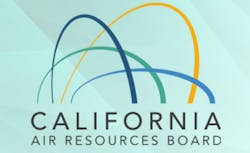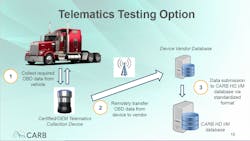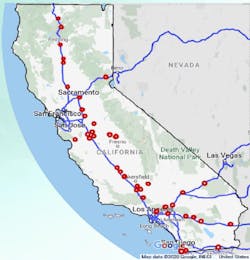CARB workshop highlights future HD inspection and maintenance program
Recently, the California Air Resources Board (CARB) hosted a webinar, “CARB Public Workshop: Senate Bill 210 Heavy Duty Vehicle Inspection and Maintenance (HD I/M) Program Development.” The workshop discussed draft concepts for California’s future comprehensive heavy duty vehicle inspection and maintenance program, presenting timelines for implementation, as well as various parameters of the program itself.
CARB provided the following information in a written statement:
CARB’s existing heavy duty vehicle inspection programs rely on random field inspections by CARB staff and annual self-inspections by truck owners to test for smoke opacity levels. However, these programs have limited ability to ensure that vehicle owners are regularly inspecting and repairing their vehicles’ broken emissions controls. A well-designed HD I/M program that creates minimal operational disruption for owners could help ensure that vehicles’ emissions control systems are operating as designed to meet California’s public health protection goals.
Proposed HD I/M program structure
The program seeks to establish periodic testing for vehicles operating in the state of California with a GVWR over 14,000 lbs. The periodic vehicle compliance testing will be conducted in one of two manners: Vehicles equipped with on-board diagnostics (OBD) will be subject to quarterly OBD testing, while non-OBD equipped vehicles will be subject to biannual opacity testing.
Proposed periodic OBD testing requirements
The CARB HD I/M program proposes a quarterly OBD data submission in line with HD OBD regulations, section 1971.1, title 13, CCR. The passing criteria of OBD data would include no malfunction indicator light (MIL)-on events, no active fault codes, and no permanent codes. If an issue is identified in the data submitted, a follow-up OBD data submission is requested to be submitted within 45 days (75 days for agricultural vehicles). A vehicle is then considered to be in non-compliance if either it misses the periodic testing submission, or a follow up data submission is not completed within the required timeframe.
The CARB HD I/M program recognizes the differences in operations for heavy duty vehicles, as well as their preferred methods of OBD testing; the program presents different options of OBD testing and data submissions. Those options include certified telematics service providers, quick stop testing locations, and third-party mobile testers.
Telematics testing option
The telematics OBD testing method is an option requiring little to no driver intervention, said CARB HD I/M program representatives. The process would be carried out as follows:
CARB is currently establishing a certification process in order to verify requirements of the HD I/M program are met by the telematics providers.
Furthermore, there are two telematics testing options, termed “Full Key Event Telematics Option” and “Minimal Key Event Telematics Option.” The Full Key Event option is meant to be a “set it and forget it” option, CARB HD I/M representatives said. This system would run a key event check within five minutes of every engine start, with OBD data being submitted upon a key event being triggered. Key events include:
- Power loss of OBD device
- Change in MIL status
- Change in electronic identifiers (E-VIN, ECU ID, etc.)
- Change in OBD monitor readiness from “Ready” to “Not Ready”
- Vehicle entering California (through optional GPS-based parameter)
- No test submission in the last 90 days
The CARB HD I/M program is currently seeking ways to incentivize use of the Full Key Event Telematics Option.
The Minimal Key Event Telematics Option has been presented through the program after stakeholders expressed concern with the Full Key Event option. One concern was that the full key option would subject vehicles to more frequent monitoring than those using other options; furthermore, those using the full key option would not have any time to review trigger events before they would be submitted to the CARB HD I/M database. The Minimal Key Event Telematics Option would submit triggered data under power loss of the OBD device, no test submission in the last 90 days, or if a vehicle enters the state of California (through optional GPS-based parameter).
Quick Stop testing option
Another option for OBD testing proposed through the program is Quick Stop testing, in which a vehicle can visit specific locations and use certified testing devices to perform necessary inspections. A certified device would automatically collect the necessary inspection data upon being plugged into the OBD port, as well as upload testing results to the CARB HD I/M database and confirm data submission. The testing results would then be available to the operator/fleet through a truck owner interface in the HD I/M database.This option theoretically would take between five to ten minutes, CARB HD I/M representatives said. The process would include kiosks installed at predetermined locations. Inside of the kiosk would be certified testing devices. Operators can visit one of the locations, remove a testing device from the kiosk, plug the device into the vehicle to complete and upload the results of the inspection, then return the device to the kiosk. A service clerk would be managing the devices at the kiosk locations. The initial proposal would include about 20 testing locations throughout the state.
Third-Party OBD Testing option
The Third-Party OBD Testing option has been modeled after the current smoke testing structure in the Periodic Smoke Inspection Program (PSIP) regulation. This option would allow trained and certified OBD testers, using CARB-certified devices, to provide OBD inspection services. The CARB HD I/M is developing training material regarding data submission that would be added to future training courses for third-party testers.
Non-OBD vehicle opacity testing
For non-OBD equipped vehicles operating in the state of California, the CARB HD I/M program has proposed a vehicle opacity testing method. This option would utilize the SAE J1667 snap acceleration testing procedure. The test is the same smoke opacity test and has the same opacity thresholds as those currently in place for the PSIP and Heavy Duty Vehicle Inspection Program (HDVIP) programs. The testing methods are the same as those in the PSIP, which include self-testing or third-party testing methods.
Proposed periodic opacity testing requirements
The CARB HD I/M program proposes non-OBD equipped vehicles be subject to biannual opacity tests. Results of the opacity test would be electronically uploaded to the CARB HD I/M database. If the submitted inspection results have an opacity issue, follow-up passing opacity test results must be submitted to the CARB HD I/M database within 45 days (75 days for agricultural vehicles). A vehicle is deemed to be non-compliant should a periodic testing submission not be submitted, or a follow up passing data submission is not submitted within the applicable timeframe.
Program interfaces for stakeholders
The CARB HD I/M program includes access to interfaces for all stakeholders. The interfaces would be broken down into three separate pieces: Truck Owner, OBD Device Certification, and Third-Party Tester.
Truck Owner interface
The truck owner website interface will serve as the entrance point to the HD I/M program for truck owners. Each owner will have a primary fleet page designed to track HD I/M compliance status. Furthermore, truck owners will be able to check test results, pay compliance fees, and obtain compliance certificates.
OBD Device Certification interface
Vendors of devices that would be submitting OBD data to the CARB HD I/M database for the program would need to certify their devices. CARB is developing technical specifications that such devices will need to comply with in order to obtain certification. OBD device vendors will work directly with CARB staff to certify devices and equipment under this proposal. The OBD Certification interface will register each individual testing device to be used in the CARB HD I/M program upon successful certification.
The testing and certification process will include both vendor testing and CARB testing of devices. Vendor testing will include initial validation testing (which will entail specific testing conditions to be defined by CARB) and field testing – where device vendors will perform “real-world testing on an applicable heavy duty vehicle population.” The definition of an applicable heavy duty vehicle population is still being constructed by CARB and program stakeholders.
CARB device testing has been proposed as testing performed by either CARB or a designated entity within a laboratory setting in order to verify vendor test results. Device vendors would receive an executive order from CARB if the device meets the specified requirements and is then certified as a CARB HD I/M program device. CARB intends the registration process establishes a way to ensure end-user data is coming from certified devices.
Third-Party Tester interface
The Third-Party Tester interface would be a website in which third-party OBD and/or opacity testers would establish and register individual accounts. These registered accounts would serve as the access point for third-party testers to submit OBD or opacity test results on behalf of vehicle owners that would use the third-party testing option for the CARB HD I/M program.
Since third-party testers will be required to use CARB HD I/M program certified devices, the interface will also serve as a device registration page for third-party testers. Furthermore, a third-party tester contact list will be made available to truck owners through the interface.
Ensuring compliance
After establishing parameters of the program, the second half of the webinar focused on how CARB HD I/M program compliance would be enforced. A range of policies and technologies were discussed as options of implementation in order to create an established network that all parties could utilize in order to ensure compliance.
Remote sensing detection
In the proposal, the CARB HD I/M program would utilize remote sensing devices (RSD) as well as automated license plate recognition (ALPR) cameras to identify “high emitters.” High emitters would be understood as vehicles producing determined levels of particulate matter and NOx emissions. The program proposes deploying real-time emissions monitoring equipment in tandem with ALRP cameras throughout the state; locations at which to deploy such equipment is currently being analyzed by CARB. The Portable Emissions Acquisition System (PEAQS) is one configuration of RDS and ALPR technology that is currently utilized in the field, in which operators drive through a roadside station while the necessary data is captured and transferred to CARB. Vehicles that are tagged as high emitters would then be required to submit passing OBD or opacity testing data results into the CARB HD I/M database within 45 days.
The ALRP camera network would also be able to monitor captured license plates and cross-check the CARB HD I/M database to identify vehicles operating in the state of California that do not possess a valid compliance certificate.
Referee network
The proposal seeks to establish a referee network for the program; CARB intends the CARB HD I/M program’s referee network to serve a similar function to the Bureau of Automotive Repair’s (BAR) light duty smog check referee stations, CARB representatives said. As the referee network is established, CARB recognizes the possibility of the referee network also being mobile. Referee testing of vehicles may be required if:
- There are anomalies in submitted vehicle data
- Vehicles are identified as high emitters
- There is suspected tampering of devices and/or fraudulent data submissions
- To resolve disputes
- Random audits
If CARB issues a referee test to a vehicle, testing must be completed within 45 days, with failure to do so possibly incurring citations.
The referee inspection process would begin by vehicle owners receiving a notification from the program through mail, email, and via the fleet page within the truck owner interface. Vehicle owners would then be able to schedule and coordinate referee testing within the truck owner interface. The referee inspection has been proposed to entail a visual inspection of the vehicle itself, a smoke opacity test, and an OBD test if applicable. The test results would be submitted to the CARB HD I/M database through a referee interface.
Field enforcement
CARB HD I/M program field enforcement efforts will operate in coordination with the California Highway Patrol (CHP). Senate Bill 210 authorizes the CHP to check for an illuminated MIL in the vehicle, check for a valid compliance certificate, and check for “visible smoke.”
Obtaining compliance certificates
Senate Bill 210 requires that vehicles possess a valid CARB HD I/M Compliance Certificate to legally operate in the state of California. The proposal puts forth the criteria to obtain a certificate of compliance as: being in good standing with periodic testing requirements, no outstanding high emitter flags, referee flags, or HD I/M citations, as well as paying the required fee. Fleets will be able to obtain a compliance certificate through the truck owner interface, with electronic and hardcopy certificates available. Furthermore, the proposal also states that a DMV registration block will be placed on California vehicles operating without a valid compliance certificate.
Proposed phase-in implementation
The proposal outlines a phase-in approach for the CARB HD I/M program, with the first phase beginning no later than January 1, 2023. In the first phase of the program’s implementation, RSD high emitter vehicle detection will focus on the San Joaquin Valley region. The proposal has also established a fleet and vehicle reporting deadline in the first phase, with the deadline to complete reporting set for July 1, 2023. In the first phase, vehicles will receive a certificate of compliance upon registering with the program with no outstanding high emitter flags and payment of the compliance fee.
The second phase of the program would begin July 1, 2023, according to the proposal. At the start of the second phase, enforcement of compliance certificate requirements would begin. Furthermore, DMV holds for California-registered vehicles would begin as well.
The proposal states that the third phase of the program implementation would begin in 2024, upon which periodic testing requirements would begin and the CARB HD I/M program would be fully operational. During the first year of the third phase, the program would “ramp up stringency on OBD parameters for compliance,” CARB representatives said.
During the webinar, CARB representatives also outlined the process of implementation for the program on the back end, which will require the hiring of a contractor or multiple contractors. The primary responsibilities of the contractor(s) would include developing and maintaining the CARB HD I/M database, establishing the Quick Stop testing and the referee networks, and mailing and issuing compliance certificates, among other responsibilities.
Proposed citation process
The proposal outlines how the program will issue citations and the actions available to clear or dispute such citations. Citations will be issued to vehicles that fail to demonstrate compliance, with a proof of compliance and payment of the penalty required to clear any citations. Should a vehicle owner fail to clear a citation, possible responses proposed include: block of compliance certificate, block DMV registration on California-registered vehicles, matter referred for civil litigation or administrative hearing, or a request of vehicle storage for “egregious violations.”
California Health and Safety Code (HSC) 44152 requires that CARB provides a cited vehicle owner an opportunity for an administrative hearing; further stipulations of the appeal process are still under development.
Closing Q&A
The webinar also provided the opportunity for attendees to present questions to the CARB representatives presenting the workshop.
A major concern that was raised was the availability or access to the vehicle’s OBD port – as many attendees claimed the port is currently utilized for ELDs or other telematics devices. Furthermore, the concern was that other maintenance practices involving the vehicle’s OBD port could trigger key events that would in turn submit data to the HD I/M program’s database for non-compliance. CARB representatives recognized the issue and claimed that technical considerations are being taken into account to ensure that proper utilization of the port, as well as data collection and reporting, is sufficient and non-disruptive.
The point was also raised that fleets have already been paying to bring vehicles into compliance, and that the program would further cost fleets and stretch payments out to multiple parties. CARB stated that they are already looking into combining the program fees with established DMV fees.
CARB representatives also stated that there will be no vehicle exemptions to periodic testing when the program begins, but that the possibility of exemptions may arise after the program acquires adequate amounts of data and should the gathered data present exemption-worthy cases.
Another concern was raised regarding the onus of compliance for rentals and leases. Multiple attendees inquired as to the vehicles that would be required to perform quarterly testing as rented or leased equipment, and how that responsibility would be enforced to the rental agency or the end user. CARB recognized that this would pose an issue for certain rentals based on the amount of time the vehicle is rented out, and they are further establishing guidelines for such cases.
In closing, CARB stated that all drafted material will be available for review to any stakeholders, and that the group will continue to host similar workshops in the future to collaborate and discuss the parameters of the CARB HD I/M program.
About the Author
Tyler Fussner
Associate Editor | Fleet Maintenance
Tyler Fussner is Managing Editor - Community Manager at Supply Chain Connect, part of the Design & Engineering Group at Endeavor Business Media.
Previously, Fussner served as the Associate Editor for Fleet Maintenance magazine. As part of Endeavor's Commercial Vehicle Group, his work has been published in FleetOwner magazine, as well as Bulk Transporter, Refrigerated Transporter, and Trailer-Body Builders.
Fussner's May 2022 print feature 'The dawn of hydrogen trucks' was named the best single technology article in B2B by the judges of the 2022 Folio: Eddie and Ozzie Awards. Fussner was also awarded Silver in the Technical Article category for the Trade Association Business Publications International (TABPI) 2021 Tabbie Awards.
Fussner previously served as Assistant Editor for Endeavor's Transportation Group on the PTEN, Professional Distributor, and VehicleServicePros.com brands.
Fussner studied professional writing and publishing at the University of Wisconsin-Whitewater. He has experience in shop operations, is a Michelin Certified Tire Technician, and a Michelin Certified Tire Salesperson.



